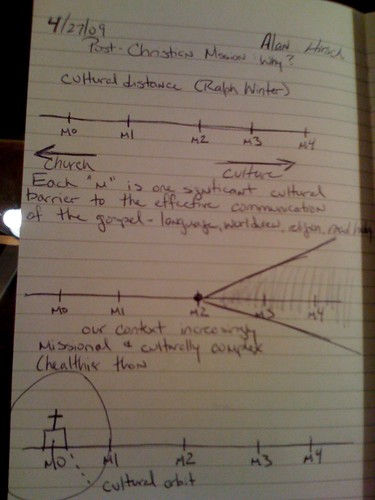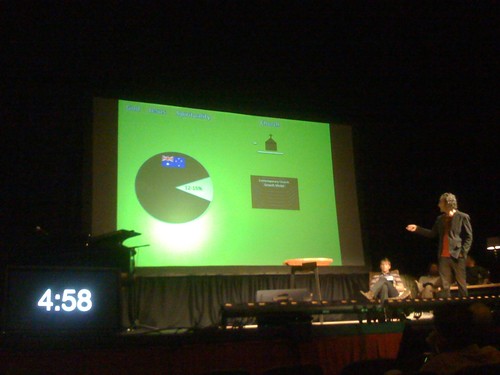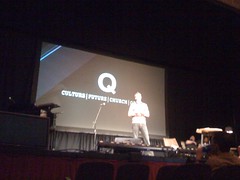The second session proved to be one of my favorites. Alan Hirsh, author of The Forgotten Ways gave a fantastic vision for the church that truly desires to be missional in the post-Christendom world and he presents a summary of it here:

It starts with this picture.
Each ‘m’ represents one significant cultural barrier to the effective communication of the gospel whether it be language, worldview, religion, racial history etc.
Based on the “Attractional” model, our missional stance in relation to the world will work only to people within a close cultural orbit.
It will not work with those in say, M3 bc they are socialized in their own context (or cultural orbit).
If an individual from this marker was to enter into the church model, it would be the seeker that would have to do all the cross-cultural work (rather than the church).
Thus, attractional in a missions environment is extractional.
Problems with extractional:
Contrary to Incarnational impulse
Violates our “sentness” as a church
Is a big problem for missioanal movement (bc again, it takes people from their culture)
Leverage is found in changing the church’s missioanl ecclesiology.
Among our current problems is that our delivery system is stuck.
90% of churches are trying to become Contemporary Church Growth Model (CCGM) attractional type of churches
This is a strategic problem.
2 more problems present themselves
because of m0-m1 cultural orbit, if it works, it will only reach the 35%-40% of people in that orbit.
CCGM is a missional problem.
And we get more of the same.
This is also organizational insanity – the problem of the church cannot be solved by the same mentality that began the problem.
“If you have dug a hole and realized that you need to dig the hole over there, the solution isn’t to keep digging in your same hole.” (just when I thought the hole analogy couldn’t be expanded upon …)
The decision we make now will affect the next era and will invoke imaginary solution to thrive in the 21s century.
My reactions:
The church needs to be different to the m2-m3-m4 …
Which means we need to rethink what it means rethink church. (I’ve been hearing that expression for so long).
I love the cultural orbit idea and I plan on using it. I think it demonstrates the realistic influence of a church. Given a particular context, this ministry can only do so much. Not that we ought to be “foolish” enough (replace with “modern”) to know just exactly to what extent, but there is humility in this idea and it’s great perspective for us a church.
Understanding our cultural orbit ought to help us with several things. First, that our current ministries, approaches, personalities, models have limits. Or for those that speak “pop” – one size will not fit all. So if you have ever said, “I would never go to a church like that” or “This person would probably never feel comfortable at a gathering like ours” then you are scratching the surface of a suitable starting point.
Second, and much, much harder is the need to create different types of “models” (read “churches”) that will reach the m3’s and m4’s. In doing so, we will have a better grasp of how to be missional and help us re-think the Gospel.
One of the values of these types of presentations is that it provides a vocabulary for thoughts you may have had but didn’t have the articulation, the research or the expertise to communicate them properly – especially to those who disagree with you.






Recent Comments